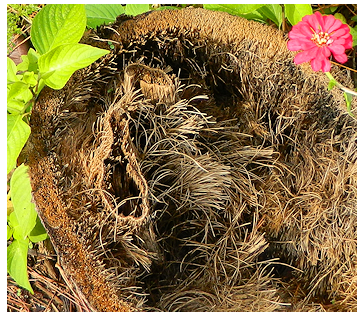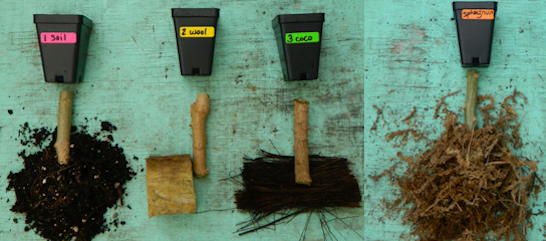Coco Fiber, Soil,
Rockwool
Experiment
 Because I live in the deep south, palm trees reside all around me. And occasionally one dies, and I am left with the wonderful,
dying trunk of said palm; fallen and now rotting on the bacteria-rich ground.
Because I live in the deep south, palm trees reside all around me. And occasionally one dies, and I am left with the wonderful,
dying trunk of said palm; fallen and now rotting on the bacteria-rich ground.
You see, palms are not like the trunks of other trees. Palm trees are actually one of the most modern plants on earth, and are not really trees at all, but through millions of years of evolution, a gigantic form of grass. If you have ever seen the interior of the 'trunk' of one, you'll see what I mean.
Palms have no rings, no hard wood, no real 'wood' of any kind really. Instead, palm hearts contain a very fibrous, stringy, thread-like material.
As humidity and time begins to break this fiber down it begins to rot. All kinds of wonderful, microscopic soil bacteria and other forms of life venture in and aid in the breakdown. It's very similar to what a living compost bin produces, only better, in my opinion.
The resulting coconut fiber is excellent at starting cuttings, adding to your soil mixes, or coaxing hard to start plants to root and thrive.
So, I've decided it's time to do a new experiment. I want to place rockwool (spun granite) against a regular soil less mix, against well rotted, organic coconut fiber. Not Coconut Coir, which is highly processed coconut trunk, ground into a dust. There is no living organisms in store-bought Coconut coir.
No, I want to use the natural stuff. It will contain all the little microorganisms that I think will make for a healthier plant.

It's the morning of July 22, 2016, and here goes my experiment. I have taken 4 approximately equal sized cuttings of Fleming Island Rachel. From left to right, I will pot each up in (No.1) regular soilless mix (compost, perlite, spent coffee grounds, peat, osmocote beads), (No.2) stone or rockwool (spun granite) (No.3) raw, well rotted coconut bark fiber with microorganisms, and finally, (No.4) a last minute thought, unmilled sphagnum moss. Each cutting will be placed in a one pint pot to speed up the appearance of roots for the experiment. All were watered with rainwater containing a few drops of humic acid. No other fertilizers or additives were used at this point. I will take pictures again and post results on or around July 29th.
Tags: Organic Coconut Fiber experiment, Organic Coconut Fiber versus Soil versus Rockwool Brugmansia Rooting Experiment


